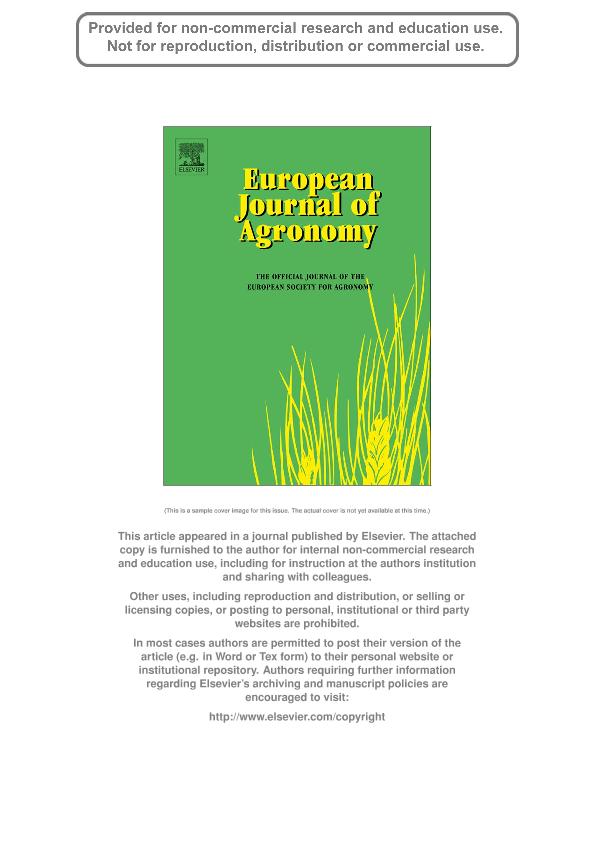Mostrar el registro sencillo del ítem
dc.contributor.author
Mattera, Juan

dc.contributor.author
Romero, Luis A.
dc.contributor.author
Cuatrín, Alejandra L.
dc.contributor.author
Cornaglia, Patricia Susana

dc.contributor.author
Grimoldi, Agustin Alberto

dc.date.available
2019-06-18T20:44:12Z
dc.date.issued
2013-02
dc.identifier.citation
Mattera, Juan; Romero, Luis A.; Cuatrín, Alejandra L.; Cornaglia, Patricia Susana; Grimoldi, Agustin Alberto; Yield components, light interception and radiation use efficiency of lucerne (Medicago sativa L.) in response to row spacing; Elsevier Science; European Journal of Agronomy; 45; 2-2013; 87-95
dc.identifier.issn
1161-0301
dc.identifier.uri
http://hdl.handle.net/11336/78501
dc.description.abstract
Lucerne sowing is characterized by a rectangular spatial arrangement, i.e. greater distance between sowing rows than between plants in the row. Therefore, the reduction of row spacing generates more square spatial arrangements that can influence intraspecific competition and resource utilization, especially radiation, and thus biomass. The experiment included different row spacings (10-15-17.5-20 and 30cm) at the same plant density in a pure lucerne crop during the first production year. Total aerial dry matter (ADM) was increased by narrow spacing (more square arrangements) up to an optimal distance (around 13cm) (R2=0.60). ADM ranged from 2292 to 1670gDMm-2 for 15 and 30cm row spacing, respectively. Plant density was the forage yield component most affected by row spacing and it increased with narrow spacing (0.15≥R2≤0.5). ADM responses to reduced row spacing were positive as revealed by both a linear increase in radiation interception (PARia) (R2=0.76) and an optimal pattern in radiation use efficiency (RUE) (R2=0.45). PARia in the first year showed an increase of 8MJcm-1 of spacing reduction. RUE values ranged from 2.0 to 1.6gDMMJ-1 for 15 and 30cm row spacing, respectively. The leaf area index (LAI) was also affected by row spacing. Additionally, seasonal variation was found for the main variables but did not interact with row spacing. In conclusion, reducing row spacing to an optimal distance is a practice that allows for more favourable spatial arrangements of a lucerne crop and has a positive impact on forage production. © 2012 Elsevier B.V..
dc.format
application/pdf
dc.language.iso
eng
dc.publisher
Elsevier Science

dc.rights
info:eu-repo/semantics/openAccess
dc.rights.uri
https://creativecommons.org/licenses/by-nc-sa/2.5/ar/
dc.subject
Alfalfa
dc.subject
Plant Density
dc.subject
Radiation Interception
dc.subject
Radiation Use Efficiency
dc.subject
Row Distance
dc.subject
Spatial Arrangement
dc.subject.classification
Otras Producción Animal y Lechería

dc.subject.classification
Producción Animal y Lechería

dc.subject.classification
CIENCIAS AGRÍCOLAS

dc.title
Yield components, light interception and radiation use efficiency of lucerne (Medicago sativa L.) in response to row spacing
dc.type
info:eu-repo/semantics/article
dc.type
info:ar-repo/semantics/artículo
dc.type
info:eu-repo/semantics/publishedVersion
dc.date.updated
2019-06-18T13:39:10Z
dc.journal.volume
45
dc.journal.pagination
87-95
dc.journal.pais
Países Bajos

dc.journal.ciudad
Amsterdam
dc.description.fil
Fil: Mattera, Juan. Instituto Nacional de Tecnología Agropecuaria. Centro Regional Santa Fe. Estación Experimental Agropecuaria Rafaela; Argentina
dc.description.fil
Fil: Romero, Luis A.. Instituto Nacional de Tecnología Agropecuaria. Centro Regional Santa Fe. Estación Experimental Agropecuaria Rafaela; Argentina
dc.description.fil
Fil: Cuatrín, Alejandra L.. Instituto Nacional de Tecnología Agropecuaria. Centro Regional Santa Fe. Estación Experimental Agropecuaria Rafaela; Argentina
dc.description.fil
Fil: Cornaglia, Patricia Susana. Consejo Nacional de Investigaciones Científicas y Técnicas; Argentina. Universidad de Buenos Aires. Facultad de Agronomía; Argentina
dc.description.fil
Fil: Grimoldi, Agustin Alberto. Consejo Nacional de Investigaciones Científicas y Técnicas. Oficina de Coordinación Administrativa Parque Centenario. Instituto de Investigaciones Fisiológicas y Ecológicas Vinculadas a la Agricultura. Universidad de Buenos Aires. Facultad de Agronomía. Instituto de Investigaciones Fisiológicas y Ecológicas Vinculadas a la Agricultura; Argentina. Universidad de Buenos Aires. Facultad de Agronomía; Argentina
dc.journal.title
European Journal of Agronomy

dc.relation.alternativeid
info:eu-repo/semantics/altIdentifier/url/http://www.sciencedirect.com/science/article/pii/S1161030112001414
dc.relation.alternativeid
info:eu-repo/semantics/altIdentifier/doi/https://doi.org/10.1016/j.eja.2012.10.008
Archivos asociados
